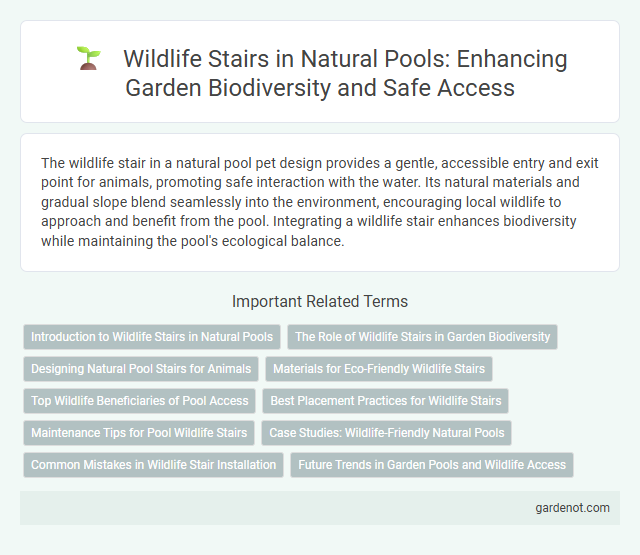The wildlife stair in a natural pool pet design provides a gentle, accessible entry and exit point for animals, promoting safe interaction with the water. Its natural materials and gradual slope blend seamlessly into the environment, encouraging local wildlife to approach and benefit from the pool. Integrating a wildlife stair enhances biodiversity while maintaining the pool's ecological balance.
Introduction to Wildlife Stairs in Natural Pools
Wildlife stairs in natural pools are specially designed structures that provide safe access for amphibians, reptiles, and small mammals to enter and exit the water. These stairs promote biodiversity by enabling seamless movement for wildlife, reducing the risk of drowning or habitat isolation. Incorporating wildlife stairs supports ecological balance and enhances the natural ecosystem surrounding the pool.
The Role of Wildlife Stairs in Garden Biodiversity
Wildlife stairs enhance garden biodiversity by providing safe passage for small animals and amphibians, reducing habitat fragmentation. These structures facilitate species movement between different garden zones, promoting genetic diversity and ecosystem resilience. Integrating wildlife stairs into natural pools supports balanced habitats and encourages the presence of beneficial insects and pollinators.
Designing Natural Pool Stairs for Animals
Designing wildlife stairs in natural pools requires careful consideration of slope gradient and textured surfaces to ensure safe and easy access for amphibians, reptiles, and small mammals. Incorporating gentle, shallow steps with natural materials like stone or wood blends seamlessly into the ecosystem while providing crucial habitats. Proper placement near planting zones enhances shelter and encourages diverse wildlife interaction within the aquatic environment.
Materials for Eco-Friendly Wildlife Stairs
Wildlife stairs designed for natural pools typically use sustainable materials such as untreated hardwood, recycled plastic lumber, and natural stone, ensuring durability and minimal environmental impact. Bamboo and reclaimed wood provide eco-friendly alternatives with strong resistance to water and decay, supporting local ecosystems. Non-toxic sealants and finishes enhance longevity without harming aquatic life, aligning with conservation goals in natural pool designs.
Top Wildlife Beneficiaries of Pool Access
Wildlife stairs in natural pools provide safe, gradual access for amphibians, reptiles, and small mammals, significantly enhancing habitat connectivity. Species such as frogs, turtles, and salamanders benefit the most, using these structures to move between aquatic and terrestrial environments for breeding and foraging. Incorporating wildlife stairs promotes biodiversity by supporting species that rely on easy pool access for survival and reproduction.
Best Placement Practices for Wildlife Stairs
Wildlife stairs should be strategically positioned near natural habitats and water sources to facilitate safe animal crossings and promote ecosystem connectivity. Optimal placement involves situating them along animal trails and migration paths to minimize habitat fragmentation and reduce roadkill incidents. Incorporating gentle slopes and non-slip surfaces enhances usability for diverse species, ensuring effective wildlife movement and conservation.
Maintenance Tips for Pool Wildlife Stairs
Regularly clear debris from pool wildlife stairs to prevent algae buildup and ensure safe access for animals. Use a soft brush or low-pressure water spray to clean surfaces without damaging materials or disturbing local fauna. Inspect the stairs frequently for signs of wear or damage and repair promptly to maintain a safe habitat for pond and pool wildlife.
Case Studies: Wildlife-Friendly Natural Pools
Case studies of wildlife-friendly natural pools demonstrate the effective integration of wildlife stairs, which facilitate safe amphibian and small mammal access between water and surrounding habitats. These wildlife stairs are typically constructed using natural materials like stone and wood, mimicking natural slopes to encourage species movement and habitat connectivity. Observations reveal increased biodiversity and successful breeding of native species in pools equipped with such features, emphasizing their importance in ecological pool design.
Common Mistakes in Wildlife Stair Installation
Common mistakes in wildlife stair installation include improper step spacing that hinders animal access and lack of stable, non-slip materials that reduce safety and durability. Incorrect placement of stairs often neglects natural wildlife pathways, limiting usage by local fauna. Ensuring proper integration with the ecosystem and using environmentally-friendly materials enhances the effectiveness and longevity of wildlife stairs in natural pools.
Future Trends in Garden Pools and Wildlife Access
Wildlife stairs are becoming an integral feature in future garden pools, designed to enhance biodiversity and provide safe access for amphibians and insects. Innovations in natural pool design incorporate eco-friendly materials and ergonomic shapes that blend seamlessly with aquatic habitats. These sustainable solutions promote healthy ecosystems while offering pool owners an aesthetically pleasing way to support local wildlife.
Wildlife stair Infographic

 gardenot.com
gardenot.com